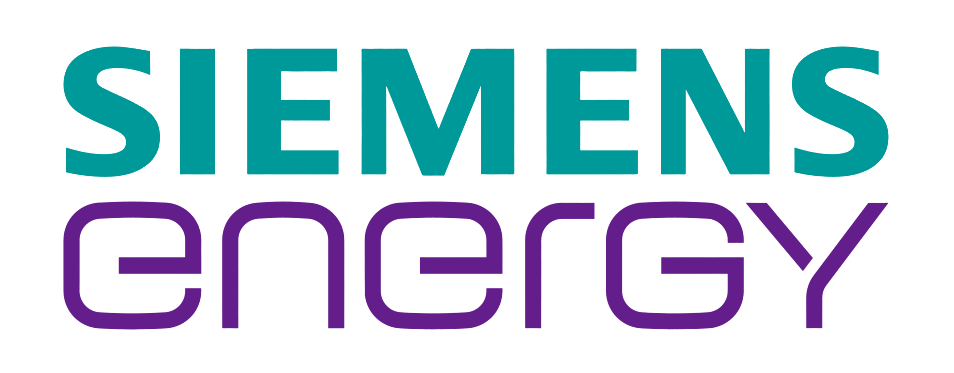The leading global concerns are climate risk and GHG emissions. Countries are moving ahead to deploy renewable technologies across industries to mitigate these environmental challenges. One such area is the ‘Buildings’ sector, wherein a transition is taking place to incorporate microgeneration technologies to reduce the emissions produced due to heat and electricity supply. Microgeneration refers to small-scale electricity or heat generation. In contrast to industrial-scale power plants that supply energy to the grid, microgeneration is the energy produced by individual homes, businesses, and even communities.
Share of energy consumption and emissions for buildings
Exhibit 1 shows that buildings have an energy consumption of ~36% of the global energy consumption. In addition, this sector accounts for ~37% of global emissions from all other sectors. The deployment of renewable microgeneration technologies for local heat (using thermally driven heat pumps – TDHPs) and electricity generation in buildings is necessary to reduce these emissions.
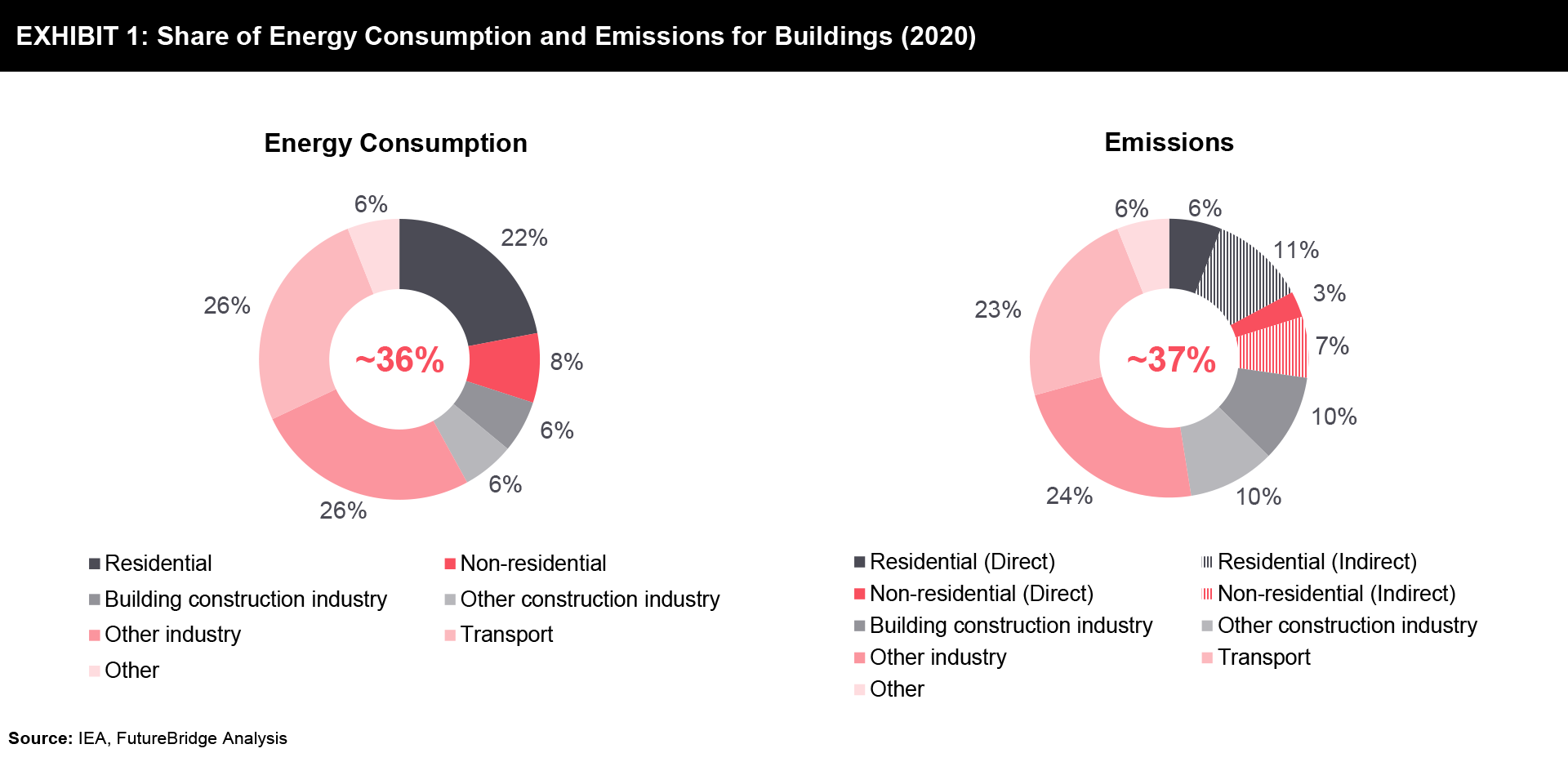

Adoption of Microgeneration and TDHPs in the Building Sector
- Microgeneration technologies provide an alternative to centralized electricity and heat generation systems which are majorly fossil-based. The technology can also reduce transmission and distribution losses in the traditional long-distance grid infrastructure.
- Microgeneration technologies include air source & ground source heat pumps, bioenergy, solar PV panels, solar thermal panels, small-scale hydroelectric systems, micro wind turbines, micro-CHP, and fuel cells.
- The trends show that the global net-zero emissions targets can be achieved by deploying a combination of microgeneration technologies as it encourages the electricity and heat consumers to participate. Many countries are providing incentivization schemes such as feed-in tariffs, in which the consumer can sell the surplus electricity generated back to the grid.
- Localizing energy generation and consumption can therefore accelerate the departure from fossil-based technologies.
- The thermally driven heat pumps (TDHP) utilize the energy stored in the soil, groundwater, or environment to heat the residential and commercial buildings. TDHPs have three technologies- compression, absorption, and adsorption heat pumps. These provide several benefits such as readiness for green gases, high energy efficiency, compatibility with existing infrastructure, etc.
- The ongoing gas price fluctuations in European countries have increased the demand for non-gas-based heat pumps. Other countries that experience extreme winters are also looking to incorporate heat pumps with low carbon emissions.
- While TDHPs exist in the European markets, they are still niche products. The sale of these products is expected to rise in the coming years as they can replace conventional boilers with an estimated one-third of the market share. The lack of awareness and high initial setup costs currently hinders the growth of TDHPs.
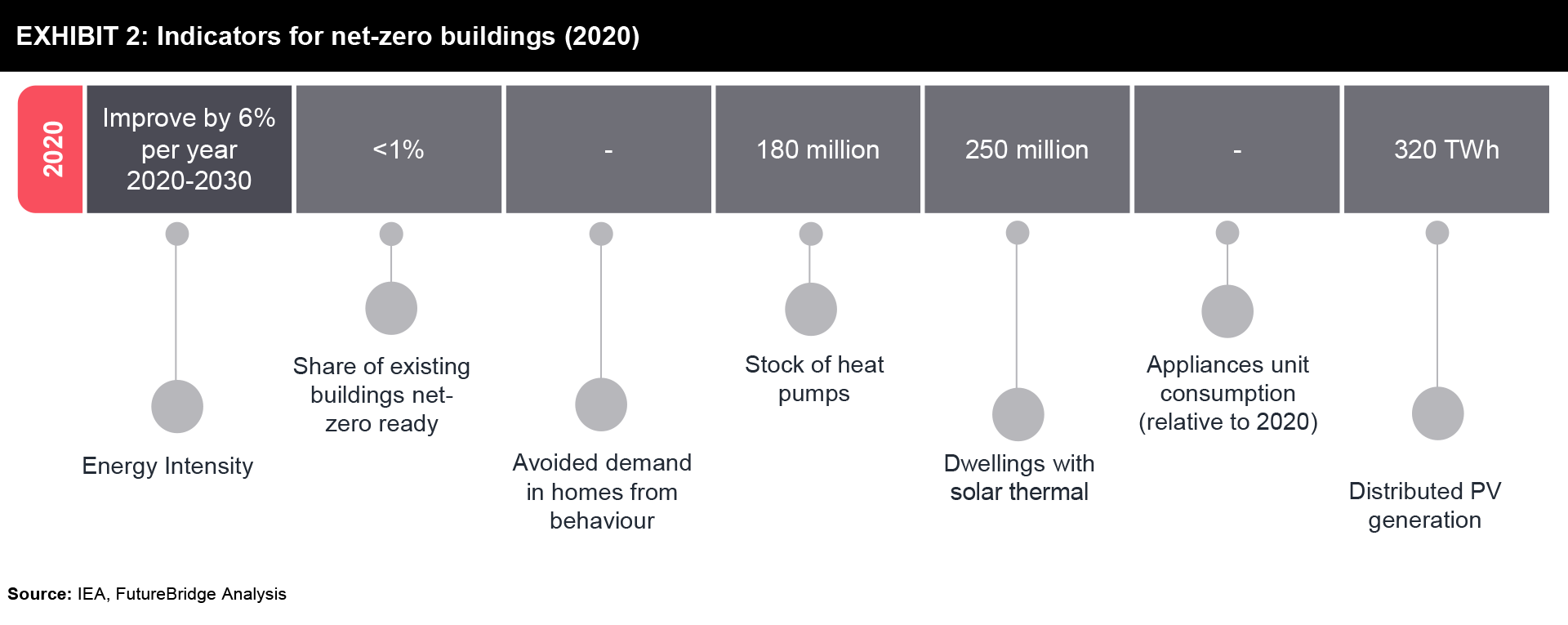

Exhibit 2 shows that till 2020, there were buildings with solar thermal, distributed PV, and heat pumps installed for local generation of heat and electricity. However, less than 1% of the existing buildings are net-zero-ready. This challenge can be mitigated by the increased adoption of microgeneration and TDHP technologies.
Building Sector Technology Evaluation
To deploy microgeneration and TDHP technologies in the building sector, it is necessary to understand the suitability and compatibility of the technologies with the existing and new infrastructure. Exhibit 3 shows that micro-wind and micro-hydro technologies are not suitable for domestic installations due to size and infrastructural restrictions, but they are relatively suitable for commercial and industrial buildings.
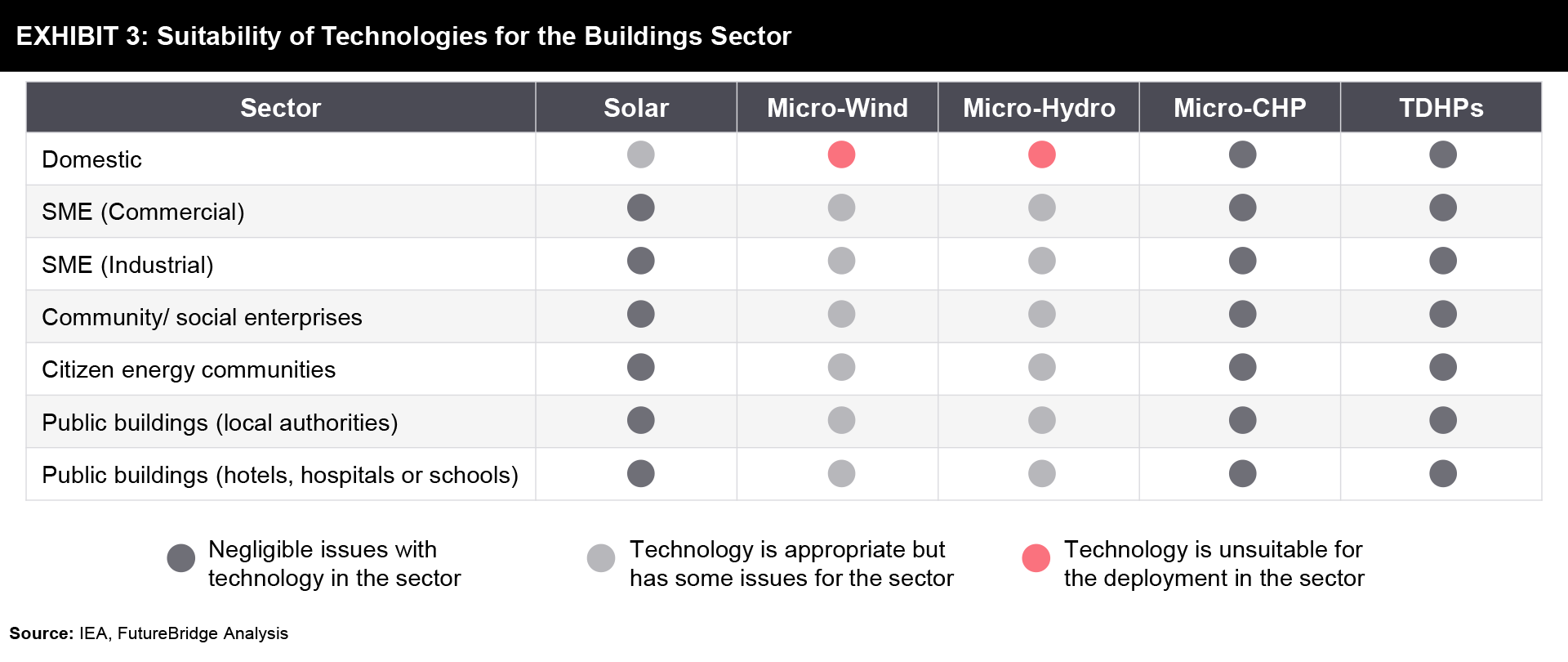

Microgeneration Schemes and Incentives
Feed-in Tariffs (FIT) are policies that support the global scaling up of renewable heat and electricity generation capacity. Producers can get a price for the electricity fed into the grid. Many countries utilize this scheme to incentivize local producers of energy. It is a vital tool for achieving the net-zero targets set by countries.
The penetration of microgeneration technologies is comparatively higher in countries like the UK. So, the UK government ended the Feed-in Tariff scheme in 2019. The MCS (Microgeneration Certification Scheme) will play a key role in the UK. This scheme standardizes and certifies the products, installers, and installations to produce heat and electricity in buildings.
Several other countries, such as Denmark, China, etc., have emphasized their net-zero commitments to promote renovations and new regulations for existing and new buildings to be energy efficient. This is to phase out the use of fossil-based heat and electricity generation systems.
Future Scenario for Microgeneration and Heat Pumps
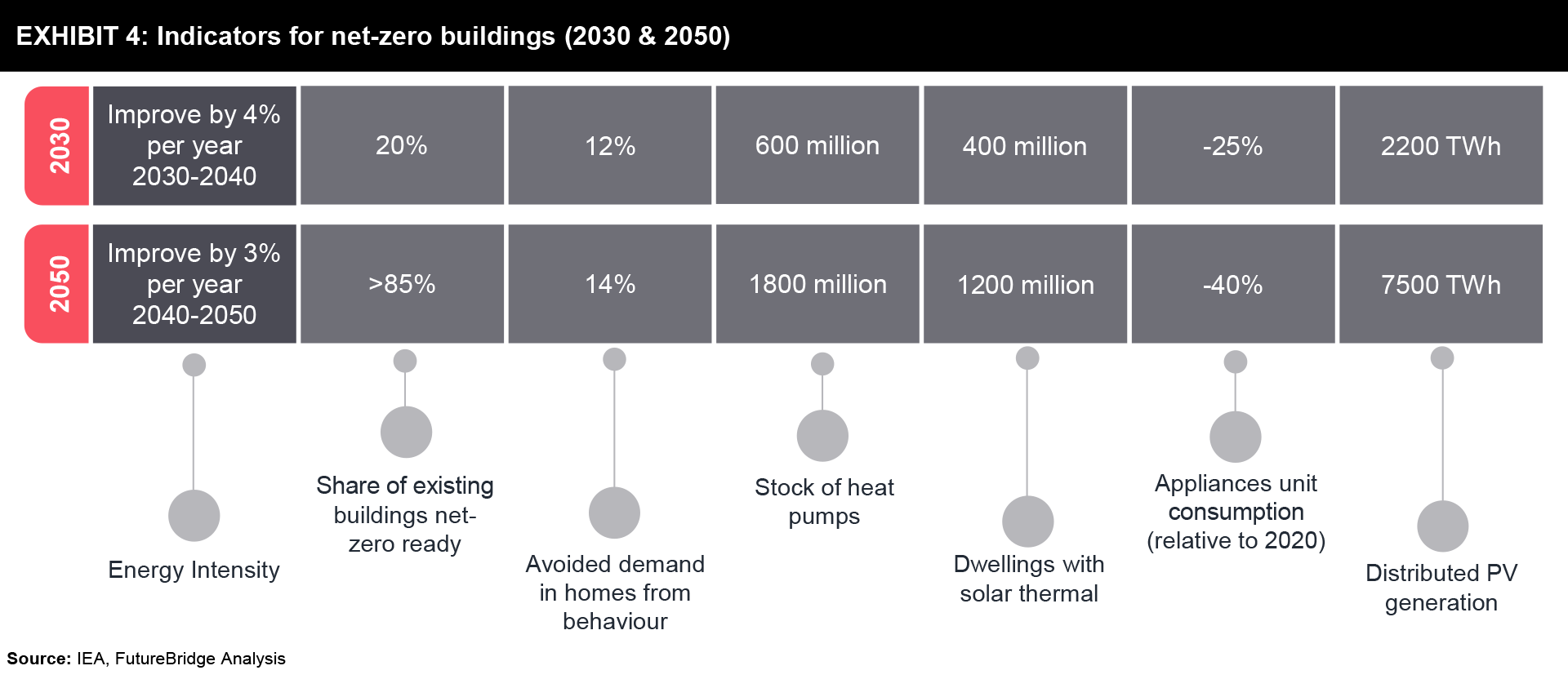

Exhibit 4 showcases the 2030 and 2050 scenarios for Microgeneration and TDHP technologies with potential growth and improvement in energy intensity of the building sector. The increase in net-zero ready buildings and efficient energy demand for buildings is due to the integration of smart microgeneration technologies that analyze human behavior and energy usage patterns for efficient building energy management.
The number of heat pumps and solar thermal and PV installations will significantly increase along with technologies becoming highly energy-efficient, resulting in a consumption reduction of ~40% by 2050. As renewable technologies become more cost-effective, these will further help in decarbonizing the Building energy sector. Thus, swift adoption of the Microgeneration and TDHPs in the Building energy sector will support countries in becoming energy self-sufficient to tackle global climate and energy security challenges.
References
- Microgeneration for buildings
- Microgeneration, the future of stable power
- UNEP, global status report for buildings and construction
- IEA, Energy Efficiency 2021
- European Heating Industry: thermally driven heat pumps
- Microgeneration Certification Scheme
- World Economic Forum: Rethinking Buildings
- Microgeneration policy options 2020
Need a thought partner?
Share your focus area or question to engage with our Analysts through the Business Objectives service.
Submit My Business ObjectiveOur Clients
Our long-standing clients include some of the worlds leading brands and forward-thinking corporations.
- © 2021 Cheers Interactive (India) Private Limited. All rights reserved. FutureBridge ® is a registered trademark of Cheers Interactive (India) Private Limited.































